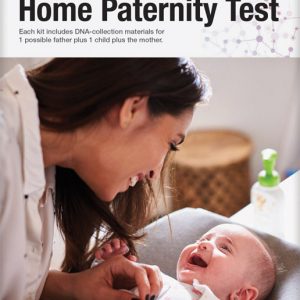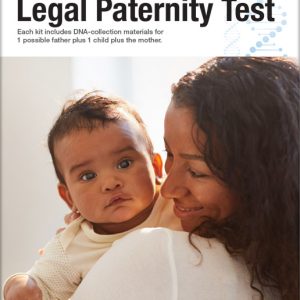
DNA Diagnostics Center (DDC) is the world leader in DNA Paternity Testing at home, performing over one million paternity tests each year. Each test is processed at our state-of-the-art facility outside Cincinnati, providing online results as soon as 24 to 48 hours after the samples arrive at our lab and go into testing. This detailed paternity test report contains scientific as well as legal terms to describe our highly precise process and your results. Here’s a breakdown of the different sections in the report and what they mean for you and your family.
Call Now: CALL NOW: 1.800.681.7162
Understanding Your Paternity Test Report
When you receive your DDC paternity test results, it may seem overwhelming at first. The report includes scientific data, terms, and complex figures that might feel difficult to interpret. This section aims to break down the report and make the results more understandable. Whether you’re seeking closure, legal confirmation, or personal clarity, understanding your test results is a crucial part of the process.
DDC Paternity Test Results Report Overview
Your DDC paternity test results report contains several key sections, each displaying important information. These sections include:
- Genetic System Table (Locus/Allele Sizes Chart)
- Combined Paternity Index
- Probability of Paternity
- Test Conclusions
Each section serves a specific function in helping to establish paternity, providing you with both statistical data and a clear conclusion about whether or not the tested individual is the biological father.
Genetic System Table
The Genetic System Table is one of the most crucial parts of your paternity test report. This table contains DNA data collected from all parties tested, and it plays a pivotal role in determining whether a biological relationship exists between the alleged father and the child.
What is a Locus and an Allele?
A locus is simply a location on a chromosome where a specific gene or marker is located. Each person has two alleles at each locus—one inherited from their mother and the other from their father. The Genetic System Table lists the loci and alleles for the child, the mother (if tested), and the alleged father.
The alleles are compared across all parties to determine whether the alleged father shares a genetic match with the child. If the mother’s DNA is tested, her alleles will also be considered in this comparison to ensure accuracy. This comparison is essential for excluding non-matching DNA segments and verifying potential matches with the alleged father.
How to Read the Genetic System Table
At first glance, the table may appear to be a list of numbers and terms that make little sense. However, each number represents the size of the alleles for the individuals being tested. In most cases, at least one allele in each locus from the child must match one allele from the alleged father. For example, if the child inherits a “16” allele from the mother, the remaining allele must match one from the father for the paternity test to indicate a match.
The table also includes a locus called Amelogenin, which is a marker that indicates the sex of each individual. A pair of X alleles indicates a female, while an X and Y combination indicates a male.
Paternity Index: Understanding the Statistics
The Paternity Index (PI) is another important part of your paternity test report. This number, which appears in the Combined Paternity Index section, represents how strong the match is between the alleged father and the child at each DNA locus.
The Paternity Index at each locus is calculated based on the likelihood that the child’s DNA was inherited from the alleged father, as opposed to a random, unrelated man from the same population group. The Combined Paternity Index (CPI) is the cumulative product of all these individual indices. The higher the CPI, the more likely the alleged father is the biological father.
For example, a Combined Paternity Index of 533,475, as shown in the report, means that it is 533,475 times more likely that the tested individual is the father than a random, unrelated man with a similar racial background. It’s important to note that this number will vary depending on the case and the strength of the DNA match.
Probability of Paternity: What Does 99.999% Mean?
The Probability of Paternity is a figure that reflects the likelihood of the tested individual being the biological father of the child. This probability is calculated from the Paternity Index and expressed as a percentage. In most cases, when a father is “not excluded” as the biological father, this probability is 99% or higher—often exceeding 99.999%. This is commonly referred to as a near-certain result, and the higher the percentage, the more likely the man is the biological father.
However, it’s important to note that no DNA test can offer a 100% probability of paternity. The calculation is based on statistical models, meaning there will always be a very small margin of error. That being said, a probability of 99.999% or higher is considered legally and scientifically conclusive.
Test Conclusions: Father or Not?
The Test Conclusion section of your report will clearly state one of two outcomes:
- Is not excluded as the biological father: This means that the alleged father is most likely the biological father, based on the DNA evidence.
- Is excluded as the biological father: This means that the alleged father is not the biological father, as the DNA analysis does not support paternity.
These conclusions are straightforward, and if you are unsure about their implications, the DDC team is available to provide further clarification.
Frequently Asked Questions: Addressing Common Concerns
What happens if there is a mismatch?
In some cases, there might be a mismatch between the child’s and alleged father’s DNA at a specific locus. You might wonder how this can happen if the Probability of Paternity is still over 99%. The answer often lies in the concept of genetic mutations. It is possible for a mutation to occur in one of the alleles, leading to a mismatch in the results. However, our experts take these mutations into account when calculating the final paternity probability. This means that even with a mismatch, the man can still be considered the biological father.
Can paternity test results be wrong?
Our testing process at DDC is extremely thorough. Each sample is analyzed twice by different teams to ensure there is no possibility of human error. If the test results exclude the alleged father, there is a 0% chance of him being the biological father. If the results indicate a high probability of paternity, the accuracy is nearly 100%. However, if two possible fathers are close relatives, such as brothers, additional testing may be necessary to avoid ambiguity due to the similarity in their DNA. It is important to let us know if there are two closely-related possible fathers.
Why are there no names on my report?
For at-home paternity tests, names are not included in the report. This is because the samples are provided by the customer, and we cannot independently verify the identity of the individuals submitting the samples. Each sample is instead labeled with an identifying number. In contrast, a legal paternity test, which requires court-admissible results, includes both the names of the individuals and company branding to verify the chain of custody.
Paternity Testing During Pregnancy
For expectant mothers who need paternity answers before the child is born, DDC offers a Non-Invasive Prenatal Paternity Test. This test analyzes the baby’s DNA, which is naturally present in the mother’s bloodstream during pregnancy, and compares it to the alleged father’s DNA. While this test contains different data from a postnatal paternity test, the report is similarly structured, ensuring results are accurate and easy to interpret.
About DNA Diagnostics Center (DDC)
DNA Diagnostic Center is the world leader in paternity and relationship testing. Our services are trusted by healthcare professionals, government agencies, and individuals globally. With over one million paternity tests conducted annually, DDC is committed to providing reliable, accurate, and confidential testing services.
Whether you’re looking for personal answers or need legal proof of paternity, DDC offers expert guidance and support every step of the way. Have more questions? Don’t hesitate to call us, we’re here to help.






I took a DNA test with another company (FastDNA) but the results came back on a DDC letter head. Do you all process results for other companies?
Hi, Kim. Yes, we maintain an extensive network of partnerships with third-party providers.
How do I know if the results i received from a lab are trustworthy? I got results from Universal Forensics (an AABB lab) and am trying to decide if I need to do another test. Thank you.
Hi, does SE33 need to be tested for a dna test? Thank you.
SE33 is included in DDC relationship tests as part of our minimum panel of 20 markers (loci) tested. If it does not appear on one of our reports, it’s an indicator that data for that marker did not meet quality thresholds. In most cases, data from other markers can compensate or we’ll test additional markers, so SE33 not absolutely necessary.